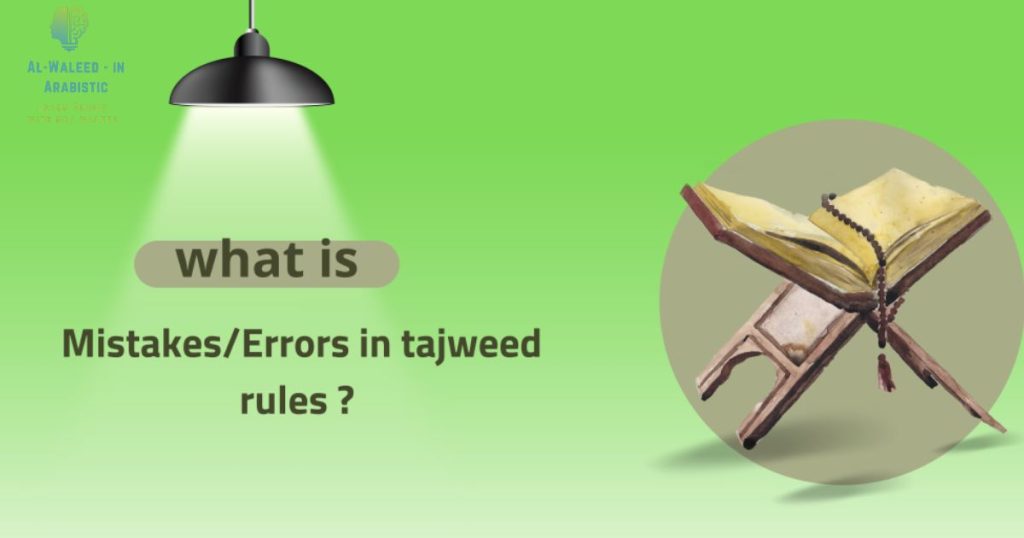Seize the opportunity to elevate your Quran recitation into a deeply devotional and spiritually enlightening practice. Our comprehensive guide to Tajweed rules will lead you on a transformative path to mastering the sacred art of Quran recitation, honoring the divine message, and enhancing your spiritual journey.
WHAT IS THE QURAN TAJWEED RULES MISTAKES?
- Have you ever found yourself questioning the melody of your Quran recitation, wondering if a particular sound is correct or a mistake? Perhaps you suspect there might be errors, but the details remain elusive. Fear not! This article is here to illuminate the path towards a more confident and melodious recitation.
- We’ll delve into the world of Tajweed, exploring the different types of melodic errors readers encounter and, most importantly, the solutions to rectify them. We’ll categorize these errors and provide clear examples, along with the rulings associated with each one. By the end of this journey, you’ll be equipped to identify and address these errors, transforming your recitation into a harmonious expression of devotion.
So, if uncertainty about Tajweed has ever cast a shadow on your Quran recitation, this article is your beacon, guiding you towards a deeper understanding and a more fulfilling experience. Let’s embark on this journey together!
Unveiling the Meaning of Mistakes in Tajweed Recitation
In the realm of Tajweed rules, the term “Lahn” (لحْن) carries a profound significance, signifying a deviation from the melodic harmony and rhythmic precision that characterize the recitation of the Holy Quran. It represents a deviation from the established Tajweed rules, disrupting the flow and beauty of the recitation.
The Essence of Lahn:
Lahn encompasses a broad spectrum of errors that can mar the recitation, ranging from incorrect pronunciation of Arabic letters to misapplication of Tajweed rules governing elongation, pauses, and intonation. These errors, akin to discordant notes in a symphony, disrupt the harmony and rhythm that should characterize the recitation of the divine message.
Delving into the Etymology of Lahn:
The Arabic word “Lahn” (لحْن) carries a rich etymological heritage, hinting at its profound meaning. It stems from the root “laḥana” (لحَنَ), which implies a deviation or inclination from the intended path. This concept aptly captures the essence of Lahn in the context of Tajweed rules, as it signifies a departure from the correct and harmonious recitation of the Quran.
The Significance of Avoiding Lahn:
- Mastering the art of Tajweed recitation and avoiding Lahn is not merely a matter of technical precision; it carries profound spiritual significance. By adhering to the established Tajweed rules, reciters ensure that the divine message of the Quran is conveyed with utmost accuracy and reverence, honoring its sanctity and enhancing the a profound spiritual connection that transcends the boundaries between the reciter and the listener.
Embarking on the Path of Tajweed Mastery:
- Avoiding Lahn and mastering the art of Tajweed recitation requires dedication, practice, and guidance from qualified teachers. By diligently studying the intricacies of Tajweed rules and seeking feedback from experienced reciters, one can gradually refine their recitation and elevate it to a level of melodic beauty and spiritual resonance that befits the divine message of the Quran.Read Also : HOW TO PERFECT YOUR QURAN RECITATION WITH TAJWEED
Lahn: Unveiling the Two Types of Mistakes in Tajweed Recitation
In the realm of Tajweed rules, the term “Lahn” (لحْن) signifies a deviation from the melodic harmony and rhythmic precision that characterize the recitation of the Holy Quran. It represents a departure from the established Tajweed rules, disrupting the flow and beauty of the recitation.
Lahn encompasses a broad spectrum of errors, categorized into two primary types:
1. Lahn Jalli (Obvious Lahn):
Lahn Jalli, also known as “clear Lahn,” refers to errors that are easily discernible and significantly alter the meaning or pronunciation of words or phrases in the Quran. These mistakes can arise due to several reasons, such as: :
-
Mispronunciation of Arabic letters: Incorrectly articulating Arabic letters, such as pronouncing the “qaf” (ق) as a “kaf” (ك) or the “tha” (ث) as a “ta” (ت), can dramatically alter the meaning of words and disrupt the harmony of the recitation.
-
Omission or addition of letters: Skipping or adding letters to words can significantly change the meaning of the Quranic text and constitute a clear violation of Tajweed rules.
-
Changing vowel sounds: Altering the pronunciation of vowel sounds, such as pronouncing the “fatha” (َ) as a “kasra” (ِ) or the “damma” (ُ) as a “sukun” (ْ), can disrupt the rhythmic flow of the recitation.
2. Lahn Khafi (Hidden Lahn):
Lahn Khafi, also known as “subtle Lahn,” refers to errors that are less obvious and may not directly alter the meaning of the Quranic text. However, these errors still deviate from the established Tajweed rules and can detract from the beauty and precision of the recitation. Examples of Lahn Khafi include:
-
Inaccurate elongation: Deviating from the established Tajweed rules governing the elongation of vowels can lead to an unbalanced and jarring recitation.
-
Misplaced pauses: Inserting pauses at inappropriate points in the recitation can disrupt the natural flow and rhythm of the Quranic verses.
-
Inconsistent intonation: Failing to adhere to the Tajweed rules governing intonation, such as emphasizing certain letters or raising the pitch at specific points, can detract from the beauty and solemnity of the recitation.
After Knowing all of the pas you need to take a look of the following blog : “5 ESSENTIAL TIPS FOR PERFECTING TAJWEED IN QURANIC RECITATION”
What is the types of (لحن جَليّ ) related to tajweed rules ?
 Errors in letter articulation:
Errors in letter articulation:
- This phrasing emphasizes mistakes that arise from incorrect articulation of letters, causing a deviation from the standard Tajweed rules
- Substituting letters: This error involves replacing one Arabic letter with another, such as mistakenly pronouncing “thaa” (ث) as “seena” (س) in the verse {ثَيِّبَٰتٖ} [التحريم:5].
- Reducing a letter, such as reducing the letter Ya’, from the Almighty’s saying:{وَٱخۡشَوۡنِي [البقرة: 150.
- Adding a letter, such as adding the letter Ya’, to the Almighty’s saying: ( دَعانِ)
-
The clear melody in the movements:
- Exchange one movement with another is like replacing the fatha with a dhammah in a word( أنعمت ) From the Almighty’s saying :{أَنۡعَمۡتَ عَلَيۡهِمۡ} [الفاتحة: 7].
-
Substituting a vowel with a silent letter: This error involves replacing a vowel sound (harakah) with a silent letter (sukoon), such as mistakenly pronouncing “بيتي” (my house) as “بتي” in the verse {أَن طَهِّرَا بَيۡتِيَ} [البقرة: 125].
- Replacing stillness with movement is like replacing stillness with fatha in the word (عهدي) from the Almighty’s saying:{عَهۡدِي ٱلظَّٰلِمِينَ} [البقرة: 124].
Tips for mastering Tajweed rules
Unveiling the Secrets of Tajweed Mastery: A Practical Guide
The Quran, a divine revelation and a cornerstone of Islamic faith, holds immense spiritual power and profound wisdom. Reciting the Quran with proper articulation and reverence is an act of deep devotion and a pathway to spiritual enlightenment. Mastering the Tajweed rules is an essential step in this journey, enabling you to recite the Quran with the utmost accuracy and beauty, honoring its divine message and enriching your spiritual experience.
- Embark on a Journey with a Qualified Guide: Seek guidance from experienced Tajweed teachers who can provide you with a solid foundation in the intricacies of the rules. Their expertise will ensure you learn the rules correctly and apply them consistently in your recitation.
2. Lay the Foundation: Master the Arabic Alphabet:
A thorough understanding of the Arabic alphabet is a prerequisite for mastering Tajweed rules. Begin by studying the correct pronunciation and articulation of each Arabic letter, paying attention to the subtle nuances that distinguish one letter from another.
3. Delve into the World of Tajweed Principles:
Once you have a grasp of the Arabic alphabet, immerse yourself in the principles of Tajweed. These rules govern the proper pronunciation, elongation, pausing, and intonation of the Quranic text. Explore resources such as textbooks, online tutorials, and audio recordings to gain a comprehensive understanding of Tajweed rules.
4. Practice Makes Perfect: Consistent Recitation is Key:
Regular practice is the cornerstone of mastering Tajweed rules. Dedicate time each day to reciting the Quran with a focus on applying the Tajweed rules you have learned. Start with short passages and gradually increase the length of your recitation as you gain confidence.
5. Seek Feedback and Correction: Continuous Improvement:
Regular feedback from experienced reciters is invaluable in your journey to mastering Tajweed rules. Enlist the guidance of a teacher or a fellow student to listen to your recitation and provide constructive feedback on your pronunciation, elongation, pausing, and intonation.
6. Immerse Yourself: Utilize Audio Recordings and Visual Aids:
Immerse yourself in the sounds of proper Quran recitation by listening to recordings of renowned reciters. Pay attention to their articulation, elongation, pausing, and intonation, and emulate their techniques in your own recitation. Additionally, utilize visual aids such as Tajweed charts and diagrams to enhance your understanding of the rules.
7. Integrate Tajweed into Your Daily Quran Recitation:
Make Tajweed an integral part of your daily Quran recitation. As you recite, consciously apply the Tajweed rules you have learned, striving for accuracy and beauty in your recitation.
8. Embrace Patience and Dedication: A Lifelong Journey:
Mastering Tajweed rules is a journey that requires patience and dedication. There will be days that test your patience, but focus on the joy of continuous improvement. However, with perseverance and consistent effort, you will gradually refine your recitation and achieve a level of proficiency that befits the divine message of the Quran.
9. Seek Inspiration from Renowned Reciters:
Listen to and draw inspiration from renowned reciters who are known for their mastery of Tajweed rules. Observe their techniques, their articulation, and their ability to convey the emotions and meanings of the Quranic text through their recitation.
10. Make Tajweed a Lifelong Pursuit: Continuous Learning:
Mastering Tajweed rules is not a destination but a lifelong journey of continuous learning and refinement. As you deepen your understanding of the Quran and the Arabic language, you will discover new nuances and subtleties in the application of Tajweed rules. Embrace this journey of continuous improvement, and may your recitation of the Quran be a source of spiritual enlightenment and divine blessings.
Conclusion
There will be days that test your patience but focus on the joy of continuous improvement.
- In the end, I hope that I have provided you with a useful article that talks about melody and its legal ruling, and what should be avoided
Follow your path to excellence and participate in Our COURSES Now take your first step towards mastering Tajweed with our best teacher



 Errors in letter articulation:
Errors in letter articulation: